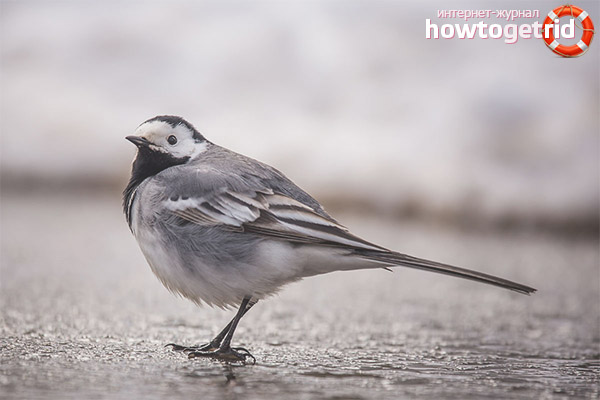The content of the article
A small slender bird with a long tail often jumps on the asphalt or side of the road in search of midges and other food. When she stops, she funnyly twitches her tail, balancing it like a tightrope walker. This is a white wagtail. The name is apt and self-explanatory, since the tail of the bird is constantly in motion. The wagtail lives next to a person, but reveals its secrets only to a very attentive and patient observer.
First Herald of Spring
As soon as the first thaws begin, a provocative little bird appears on the thawed patches. She runs fussy, catching rare midges, a swaying tail makes a smile and uplifts. It is called an icebreaker because often its arrival coincides with the opening of ice in water bodies. The wagtail species is widespread in all countries except permafrost regions.
The bird’s outfit is not very catchy, but quite memorable. The feathers on the head and abdomen are white, on the top of the head there is a black speck in the shape of a cap, and on the chest there is a black “tie”. On the wings and tail, gray and white feathers alternate, forming thin stripes. Males are brighter, in females the color is slightly more restrained. The body length is about 20 cm, half falls on the tail. A thin beak immediately gives out an insectivorous bird. Graceful legs are adapted not only for jumping, but also for an important walking step, accompanied by polite nods of the head.
Courting, nesting and raising offspring
When the pair has formed, the construction of the nest begins. The main work will be performed by the female, the partner supplies her with building material. The nest resembles a cup in shape; it is lined with down, moss or wool. Birds select for its construction a secluded place in the bushes, shallow crevices or hollows. A small hole will do. It takes 1 to 2 weeks to build, after which the nest sometimes awaits its residents for several days.
During the season, wagtails manage to breed offspring twice. The first brood falls in the spring, the second - in the middle of July. In the nest there are usually 5-6 gray or speckled blue eggs. After 2 weeks, chicks hatch. Both parents are equally involved in feeding. The white wagtail feeds on insects. On its menu:
- flies;
- larvae;
- butterflies;
- caterpillars
- beetles;
- coastal invertebrates;
- dragonflies;
- mosquitoes.
Chicks quickly grow on protein feed and after 3 weeks they fly out of the nest to leave it forever. The life expectancy of an adult reaches 10 years. While chicks hatch twice a year, it is not surprising that the wagtail has become one of the most common birds, along with a sparrow and a dove.
Lifestyle
Bird refers to migratory. In early November, flocks are sent to the shores of the Mediterranean Sea. In the middle lane, they can simply migrate a little south of the nesting sites in search of food. Birds living in the city do not bother to fly, quietly waiting for the winter near human housing.
The favorite habitats of the wagtail are the shores of reservoirs, parks, gardens, forest belts. The bird obtains food in different ways.
- It runs on the ground, carefully inspecting each leaf and pebble, pecking larvae and caterpillars from under them.
- It stands near the shore, closely watching the flight of insects. A bug, fly, or butterfly falling to the surface of the water is considered its legal prey.
- She is able to hang in the air, quickly working wings and catch insects in flight.
City birds solve the problem of food in a similar way by adding seeds and grains to them, scattered in bird feeders. Inhabitants of streets and squares most often choose hangars, railway bridges, storage rooms, attics of residential buildings for living.
Interesting Facts
- Parents feed the chicks every half an hour.
- If a young individual early flew out of the nest, then the mother and father must feed it until it becomes independent.
- Males are able to unite to repulse a hawk or other predator.
- The bird can have a great dinner, sitting on the back of a cow or horse and pecking insects from it.
- 2011 was marked by the wagtail.
- The bird is almost impossible to catch at rest.
- She is easily tamed.
The white wagtail is of great benefit, destroying insects - pests in gardens, gardens and parks. Due to its mobility, it easily overtakes prey on land, water and in the air, significantly thinning out the rows of mosquitoes, flies and caterpillars. The bird is so popular that in each locality gets its name. Wagtails have become a familiar part of the environment, adorning every day with their activity, a simple little song and a swaying tail.
Video: White Wagtail (Motacilla alba)











Submit